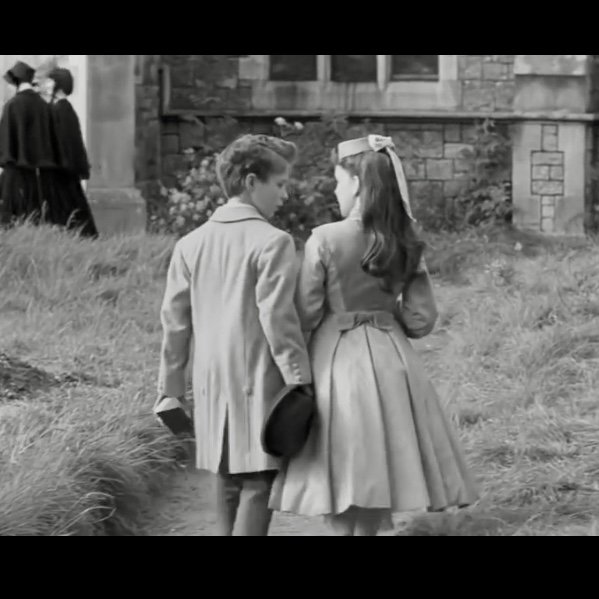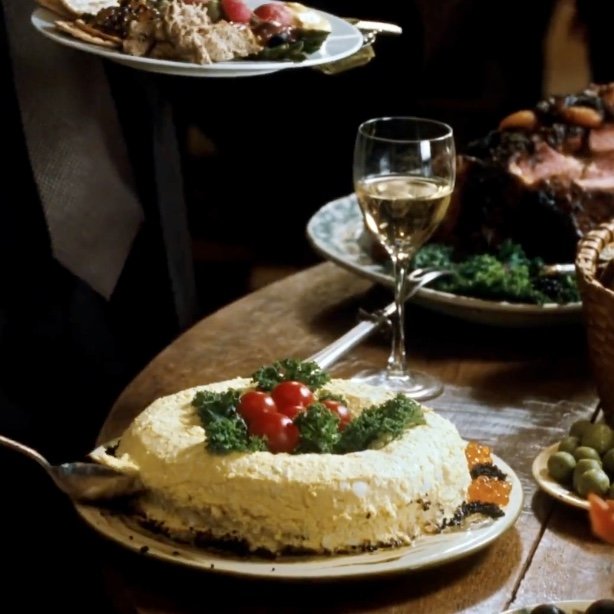“Secretive; Whispery; Indecent”: Intentional Disconnect in 1961’s The Innocents
More gothic folklore than gruesome gore, Jack Clayton’s beautifully haunting (and hauntingly beautiful) 1961 film, The Innocents is high-art psychological horror. Co-written by William Archibald and Truman Capote, the film is based on the 1898 Henry James story, The Turn of the Screw.
Deborah Kerr stars as Miss Giddens, a governess hired to care for two children, Flora (Pamela Franklin) and Miles (Martin Stephens), at an English manor. An unsettling tone is set right from the beginning: Behind the initial screen blackness, pre-opening credits, the sound of a young girl (Flora) singing “O Willow Waly” creates a disturbing blurred line between wholesome lullaby and its mournful lament for a lost lover. The disconnect continues through the opening credits, now with birds chirping in the darkness; those familiar tweets most often heard at daybreak, instead of in the dead of night. And finally, a profile of a distressed Miss Giddens, clutching her hands together, tilting her head back with her eyes closed, her forehead glistening with perspiration; the sight of sweat common in the blazing sunlight, not in the glowing moonlight.
Day or Fright
Throughout the crisp, black-and-white film there are a number of bone-chilling scenes. The manor and its grounds become settings for strange goings-on, ones not solely reserved for the nighttime, when fatigue, shadows and imagination can get the best of someone, but in broad daylight as well, often with others nearby. But what is real, and who is credible? In the film’s first line, a sense of doubt is immediately placed upon the viewer toward Miss Giddens, when the children’s uncle asks her during the interview for the governess position: “Do you have an imagination?” An almost embarrassed Giddens replies with a yes. As the film progresses: To believe or not to believe her, that becomes the subsequent question in the viewer’s mind.
Depth of Fear
The crisp black and white mentioned earlier is the work of the cinematographer, Freddie Francis, who used a deep-focus technique, which allows the foreground, middle ground and background to be equally sharp. One of the best examples is when Flora becomes oddly excited about nature’s brutality. She declares: “Oh look, it’s a lovely spider, and it’s eating a butterfly!” (Spiders aren’t usually described as lovely, creating another example of intentional disconnect.) The large depth of field simultaneously creates distance and claustrophobia for the viewer (a visual disconnect), while also establishing Flora as the spider to Miss Giddens as the butterfly.
Brother and Sinister
In addition to this macabre outlook on nature, mature subtexts run throughout, particularly ones dealing with the misguided affection between Miles and Miss Giddens. After learning more about two of the manor’s previous residents, Giddens begins to suspect the prim, proper, poetic Miles, and the once-sweet now emotionally hysterical, Flora are not who they appear to be, that something evil has entered the innocent (foreshadowed when Giddens admires a stone cherub in the garden, only for a cockroach to crawl out of its mouth).
Giddens conveys to Mrs. Grose, the housekeeper enveloped by extreme denial, that both children “are playing, or being made to play, some monstrous game. I can’t pretend to understand what its purpose is; I only know that it is happening: something secretive, and whispery, and indecent.” (Undoubtedly, Capote-penned prose.)
The relationship between Miles and Flora becomes suspect as well. Flora seems to have a psychic connection to Miles, knowing when Miles will return home from his school, permanently dismissed for bad behavior, even before Miss Giddens or Mrs. Grose. Giddens becomes watchful of the two siblings as they hold hands, walking closely together toward the town church. A concerned Giddens says to Mrs. Grose: “Look at them. What do you think they’re saying?… They’re talking about them; talking horrors.”
And the horrors continue through the film’s dizzying conclusion (or disturbing connection to its beginning, as described earlier), one that is both spine-tingling and heavyhearted, where the secretive becomes communicative, the whispery reaches its crescendo, the indecent once again innocent.
Bundle Up: Four Films for Fall
For many of us, skies are still blue and temps are still warm. So it may be hard to get into fall-season feels. But before you know it, nature’s A/C will kick in, and we’ll find ourselves wanting to bundle up under a throw, and get all comfy, cozy, and ready to watch a fall-season flick. Here are four films that are the motion-picture equivalent of a great big hug, ones that make you feel warm, not like on a summer day, but in a warm and fuzzy kind of way:
Screen Time
The 1998 Nora Ephron film, You’ve Got Mail delivers fall-season vibes big time: Tom Hanks; Meg Ryan; a witty rom-com script; New York in the fall (“makes me wanna buy school supplies”); a heartwarming soundtrack; the unforgettable Parker “I’m having my eyes lasered” Posey. Back then, it was dial-up email, now it’s Wi-Fi, social media, and sliding into someone’s DMs that can create love connections. Classic cinematic themes of opposite attract, the importance of internal beauty, and a tireless faith (fate) in love make this a fall-season film essential.
“I didn’t know who you were with.”
Right from the opening credits, which glides the viewer into a beautiful apartment, drapes flapping in the cool breeze, to a buffet table of savory selections, this film is the epitome of cozy cinema.
Come on in!
And remember, “that caviar is a garnish!”
“You’re taking all the caviar?!”
Change of Heart
Nine years prior to You’ve Got Mail, there was Rob Reiner’s When Harry Met Sally… The Nora Ephron-penned screenplay gave new life to the romantic comedy, allowing the viewer to watch the relationship between a man and a woman, the former who believes men and women can’t be friends, develop into just that, and eventually something more. Like summer turning into fall, the film is all about transition: each goes through a major breakup (Harry with Helen, Sally with Joe); the passage of time, complete with changes in fashion and hairstyles; and most significantly, time, and life lessons, cultivate a slightly more mature Harry, and a slightly less persnickety Sally. No one is completely transformed, but each undergoes a change of heart, entertaining the notion of letting someone in, not just someone new, but someone drastically different.
During the scene that has Harry (Billy Crystal) and Sally (Meg Ryan) walking through the park, Sally sharing details (or lack thereof) of a longstanding sexual fantasy, the cinematographer, Barry Sonnenfeld captures the various orange hues and verdant shades of green in the trees. Just as the colors of the leaves begin to change, a natural visual indicator of autumn’s arrival, a shift begins for Harry and Sally. Sharing of a sexual fantasy is reserved for a more intimate bond, but here it’s shared in the context of a budding, once highly unlikely, friendship.
“Well sometimes I vary it a little.”
In another scene, Sally, in a warm and toasty red turtleneck, confides in Harry about why she and Joe broke up. The “I spy a family” monologue is Ephron prose at its best. Sally mentions at the start of her story how she and Joe “wanted exactly the same thing.” But by the end of the story, they reach a crossroads, their “wants” become “needs”; it’s another change of heart, but it’s the type that divides people apart, instead of drawing them together.
“And I started to cry.”
As the film reaches its climax, not of the iconic deli-scene kind, it’s no surprise that it takes place on New Year’s Eve, the ultimate time of the year that signifies transition. Ephron writes another heartfelt monologue, this time Harry expressing an epiphany: “… When you realize you want to spend the rest of your life with somebody, you want the rest of your life to start as soon as possible.” I’ll have what he’s having.
“I love that it takes you an hour and a half to order a sandwich.”
Shue In
This next movie may not immediately conjure up images of autumn, or New York in the fall, but Chris Columbus’ Adventures in Babysitting has that fall-season state of mind. The 1987 comedy is set partially in the Chicago suburbs, and Columbus once again captures crisp, upper-middle-class living, suddenly turned upside down (a theme he would continue to explore in 1990’s Home Alone and 1994’s Mrs. Doubtfire).
Elisabeth Shue stars as Chris Parker, a suburban teen turned reluctant babysitter. Chris and the trio of kids now in her care are forced to leave the sheltered confines of suburban life, and head into the big, bad city to pick up Chris’ friend, Brenda (Penelope Ann Miller), who’s stuck in a downtown bus station. En route, everything that could possibly go wrong, does, and Chris must tap into her highly underdeveloped street smarts.
Shue’s Chris Parker is the anti-Ferris, an underrated heroine of the ‘80s teen-comedy genre.
All the while, Chris tries to stay cool, and keeps warm, wearing gloves, a multicolored striped scarf, and a long brown coat that she inherited from her grandfather. A gold heart-shaped brooch rounds out the look; all are style cues indicative of Chris’ inherent maturity, and capability, well beyond her years. By film’s end, the character of Chris becomes the anti-Ferris, an underrated heroine of the ‘80s teen-comedy genre. Shue is lovable, relatable, and completely convincing in the role as the “every girl” in extraordinary circumstances.
The adventure begins.
And we can’t forget Thor-obsessed Sarah (Maia Brewton), the coolest tyke on roller skates.
“You want some orange?”
Mama Drama
Chris Columbus’ films showing the family structure in disarray still managed to have a comedic tone; Mrs. Doubtfire the prime example of this, as it tackled divorce, and what happens when a parent is replaced by someone who not only fills the void, but seemingly fills the position better. In 1998’s Stepmom, Columbus continued with the theme of divorce and parental replacement, but added more turmoil and tears.
Susan Sarandon’s Jackie Harrison is co-parenting two children with ex-husband, Luke (Ed Harris) and his new girlfriend, Isabel (Julia Roberts). Jackie and Isabel are at odds, with one of their wars of words taking place on a fall-leaf-covered battlefield, a fitting environment for Jackie to reveal her cancer diagnosis to Isabel.
“You guessed the wrong secret.”
Behind Isabel, the trees are alive and green, but cut to Jackie, and she almost blends into a background of fallen orange and yellow leaves, and somber earth tones. It’s after this exchange that their relationship softens, temporarily, and for the moment the tears dry, with death at one point even seen as comic relief. A Thanksgiving-themed school play features Jackie’s son, Ben (Liam Aiken) as a flying turkey (on wires) that is shot by prop bows and arrows, and muskets. A horrified Isabel asks Jackie: “Is he dead?” to which an unfazed Jackie replies: “Yeah, they killed him, but he does it so great!”
“Are you dying?”
The story continues through the fall, and into winter, culminating in the emotional “And you can have their future” scene, the beautiful midnight horse ride, and finally, a warmhearted Christmas morning, with Ben, a budding magician, receiving a gold cage with a white dove as a surprise gift; the dove also serving as a symbol of peace, the newest member of the Harrison family.
“Not today!”
So when that autumn chill begins to fill the air, get comfy on the couch with one, or all four, of these fall-inspired flicks. Which one will you bundle up with first?



















